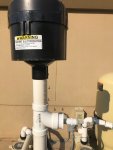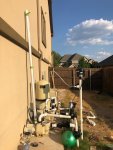First of all, thanks again to all in this invaluable forum.
We're over a year into our build, and have water in the pool, and nearly everything complete. However, I cannot get attention from my pool builder and am past the point of frustration. I got a verbal agreement from her to have the balance of the work completed by a 3rd party, and fund out of the remaining draw that is owed to her. Here's my construction thread.
I need help! One of the issues still present is the blower. The blower will run for a few minutes, and then trip the thermal shutoff after ~2 minutes. I've read nearly every thread about blower issues on this forum, but haven't been able to figure it out. The breaker isn't getting tripped, only the thermal cutoff switch.
Here are some specs of my setup, and also some troubleshooting I've performed:
Specs:
Model: Jandy PSB215 - 240v 1.5HP blower
# of 90's (all sweep 90's): 6 (there used to be 9 in order to have the blower mounted against the house, but I've removed those extra 3 for now)
# of 45's: 1
# of 1/2 lb check valves: 1 (also have run without the check valve)
# of jets in Spa: 6
Model of Jets: Waterway plastics Poly Storm T-Body Assembly (Model# 229-1110)
Length of pipe (lateral) from SPA to Blower: ~88 feet of 2.5" pipe, converts to 1.5" at the air plumbing "ring" around the spa, and to 2" at the equipment pad to connect to the blower.
Distance between center of spa jet and top of water level in spa: 10 inches
Distance between center of spa jet and top of blower: 2 feet below (my equipment pad is below the waterline as we're on a grade).
Troubleshooting performed:
I've calculated the backpressure using the formula provided by Jandy -- by calculation, I'm way under the maximum back pressure.
I've removed 3 "unnecessary" sweep 90's that were used to mount the blower to the wall behind equipment pad, instead of just coming straight out of the ground.
I've taken run the blower off of the standpipe and run it with zero backpressure -- it will run more than 30 minutes, to me indicating a backpressure concern.
I've tried running the blower when the pool is in "pool mode" (no water running being pushed through the SPA jets) -- the blower will run longer, ~10 minutes before shutting off.
I've tried running with and without the check valve -- still shuts off even without the check valve.
I've tried running the blower at various speeds of the spa pump (variable speed pump) -- still shuts off after about 2 minutes even at the lowest speed possible on the SPA pump.
I've tried running without the "Spa internal" (aka jet) -- removed the "jets" from the "Jet bodies", same result.
Planned troubleshooting: running without the "Jet bodies" installed
Planned troubleshooting: running the blower with the SPA drained (no water) and see if it shuts off
As you'll see in the pictures, there is one "Hartford loop" at the point of the SPA. However, there is still a small amount of water that collects at the bottom of the PVC at the equipment pad. Some of the diagrams show the "hartford loop" as two "ups and downs" instead of just one -- to me this would just be adding more back pressure as I'd be inserting 4 more 90's, but I haven't tried that yet.
I have a call into Jandy to see what they recommend. And before anyone says "have your PB fix it", I could do that, but they're so inept, I'm positive I know more than they do about this.
Any suggestions to matter how small are appreciated!!
Youtube Video of SPA plumbing:
Pics Below:
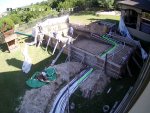
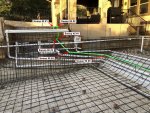
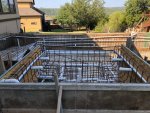
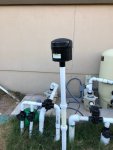
Note -- the "insert" in the PVC standpipe is just the SWCG bypass tube which conveniently connected to the 2" Unions. Normally the check valve goes here.
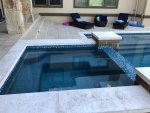
We're over a year into our build, and have water in the pool, and nearly everything complete. However, I cannot get attention from my pool builder and am past the point of frustration. I got a verbal agreement from her to have the balance of the work completed by a 3rd party, and fund out of the remaining draw that is owed to her. Here's my construction thread.
I need help! One of the issues still present is the blower. The blower will run for a few minutes, and then trip the thermal shutoff after ~2 minutes. I've read nearly every thread about blower issues on this forum, but haven't been able to figure it out. The breaker isn't getting tripped, only the thermal cutoff switch.
Here are some specs of my setup, and also some troubleshooting I've performed:
Specs:
Model: Jandy PSB215 - 240v 1.5HP blower
# of 90's (all sweep 90's): 6 (there used to be 9 in order to have the blower mounted against the house, but I've removed those extra 3 for now)
# of 45's: 1
# of 1/2 lb check valves: 1 (also have run without the check valve)
# of jets in Spa: 6
Model of Jets: Waterway plastics Poly Storm T-Body Assembly (Model# 229-1110)
Length of pipe (lateral) from SPA to Blower: ~88 feet of 2.5" pipe, converts to 1.5" at the air plumbing "ring" around the spa, and to 2" at the equipment pad to connect to the blower.
Distance between center of spa jet and top of water level in spa: 10 inches
Distance between center of spa jet and top of blower: 2 feet below (my equipment pad is below the waterline as we're on a grade).
Troubleshooting performed:
I've calculated the backpressure using the formula provided by Jandy -- by calculation, I'm way under the maximum back pressure.
I've removed 3 "unnecessary" sweep 90's that were used to mount the blower to the wall behind equipment pad, instead of just coming straight out of the ground.
I've taken run the blower off of the standpipe and run it with zero backpressure -- it will run more than 30 minutes, to me indicating a backpressure concern.
I've tried running the blower when the pool is in "pool mode" (no water running being pushed through the SPA jets) -- the blower will run longer, ~10 minutes before shutting off.
I've tried running with and without the check valve -- still shuts off even without the check valve.
I've tried running the blower at various speeds of the spa pump (variable speed pump) -- still shuts off after about 2 minutes even at the lowest speed possible on the SPA pump.
I've tried running without the "Spa internal" (aka jet) -- removed the "jets" from the "Jet bodies", same result.
Planned troubleshooting: running without the "Jet bodies" installed
Planned troubleshooting: running the blower with the SPA drained (no water) and see if it shuts off
As you'll see in the pictures, there is one "Hartford loop" at the point of the SPA. However, there is still a small amount of water that collects at the bottom of the PVC at the equipment pad. Some of the diagrams show the "hartford loop" as two "ups and downs" instead of just one -- to me this would just be adding more back pressure as I'd be inserting 4 more 90's, but I haven't tried that yet.
I have a call into Jandy to see what they recommend. And before anyone says "have your PB fix it", I could do that, but they're so inept, I'm positive I know more than they do about this.
Any suggestions to matter how small are appreciated!!
Youtube Video of SPA plumbing:
Pics Below:




Note -- the "insert" in the PVC standpipe is just the SWCG bypass tube which conveniently connected to the 2" Unions. Normally the check valve goes here.



